#costume armour
Explore tagged Tumblr posts
Text
Very impressive - and though I don't know if it's intended as such, @dduane reminds me that Halloween is coming.
What goes underneath and on legs / feet is entirely up to the wearer, but good accessories would be a belt or baldric and a toy sword from, for example, Liongate Armory or their US equivalent.
Just a thought. :->
*****
I mentioned toy swords specifically because a quick look suggests LARP foam or even poly trainer weapons seem a bit pricy for worn-one-night-only costume props.
Toys can be more than adequate. I got the one in the middle years ago in - appropriately enough - a Halloween supply shop. IIRC it cost about €10-15.00, yet looked pretty good. Being a realistic size and shape (compare it to the real steel repros either side) helped a lot.

*****
Knitted "chainmail" used to be the standard for theatrical and screen costume work (in a lot of cases I'm sure it still is).
It would start out looking like this (pattern source on Etsy)...

...then would be dyed black (if not actually made with black wool or string from the outset) and finished by dry-brushing with metallic silver or gunmetal paint. The end result was like this example from "Robin of Sherwood".

Knitted mail wasn't just used in low-budget stuff. Here are a couple more examples from Big Screen movies. The first is "El Cid" (1961)...

...as is this next one, though frankly that seam down the leg should have been inner thigh not outer.

This is "The War Lord" (1965) one of the few films I can think of with Norman-era setting and costumes.

AFAIK its budget was well below that of El Cid, but the armour in The War Lord looks better (IMO, anyway) because those buckles and contrasting red lining enhance its appearance and add "visual interest".

PVC mail as pioneered in "The Lord of the Rings" films is much more realistic and even hangs correctly, being made the same way as The Real Thing, but it's obvious that with a bit of thought given to details, well-made, well-finished knitted mail isn't bad at all.
Here's some real mail for comparison.


Here's a close-up of the first one, along with a close-up of PVC plastic mail. The rivets on the real mail are clearly visible, while the costume armour rings, which don't have to keep pointy stuff out, are just as clearly non-rivetted ("butted") for ease of manufacture.


Side-note - that little button is an in-period inventory tag...

...marked with the city arms and "Z(eughaus) v(on) Nverenberg" (Armoury of Nuremberg) suggesting that this wasn't someone's personal armour but was kept in Official Storage and issued to the militia when required.
A detail for worldbuilding, perhaps?
:->



crochet armour by katelyn tatay (2024)
24K notes
·
View notes
Text

My daughter came out to me as gay this year's pride, and to celebrate she got her own armour. Has to be my favourite family photo.
#trans#pride#transgender#lesbian#gay#queer#armour#armor#knight#plate#sword#shield#chainmail#larp#larping#cosplay#costume#flag#handstitched#me#myself#and i
971 notes
·
View notes
Text

Augsburg accountant Matthäus Schwarz in armour, 1521
Military and civil fashion were closely related during the 16th century. When Augsburg accountant Matthäus Schwarz marched out of the city to greet Ferdinand of Austria in 1521, he did not only wear his elaborate armour, but also this striped satin outfit with a huge plumed beret, which was simply worn on top of his helmet. Even though he was neither a professional soldier nor a nobleman, owning high-quality clothes, armour and weapons was expected from a respectable citizen like him. Here, he is armed with a short Katzbalger and a huge two-handed sword called a Schlachtschwert.
I need to accept that I will never look as cool as a 16th century Accountant. Painting from the fashion-book of Matthäus Schwarz, here shown at 24 years of age.
#historical fashion#historical costuming#renaissance fashion#renaissance#16th century#fashion history#16th century fashion#history#sword#armour
214 notes
·
View notes
Text






Roman Crocodile Parade Armour, 3rd To 4th Century CE, Manfalout, Egypt, The British Museum, London
The incorporation of the province of Egypt into the Roman Empire put Rome and her people into direct contact with Egyptian culture and religion. In Egypt Roman garrisons were closely integrated into civic and religious life and participated in local cults.
In Middle Egypt and Manfalout (in the ancient nome of Lycopolite) Roman soldiers were particularly attracted to the Crocodile cult centred on the sacred grottoes of the region. This parade helmet and cuirass, based upon actual military armour, was especially constructed out of crocodile skin for use in the cult processions.
#roman soldiers#romans#roman empire#roman armour#archaeology#ancient cultures#crocodile skin#roman#ancient living#ancient craft#armour#relic#parade costume#roman army#reptile
192 notes
·
View notes
Text

#medieval#middle ages#king#england#chain mail#armour#chainmail#heraldry#history#europe#european#costumes#costume
1K notes
·
View notes
Text





IG - spideynick27
#spndxjck2#guys in spandex#compression gear#under armour#spiderman#costume#body suit#cosplay#gingers
225 notes
·
View notes
Photo

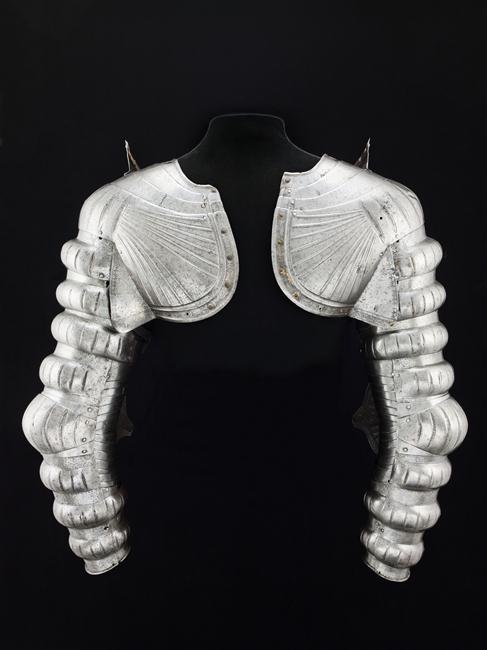
A pair of elaborate puffed and slashed Arm Harnesses, Germany, ca. 1520, housed at the Musée de l'Armée.
#armor#armour#costume armor#puffed and slashed#europe#european#germany#german#hre#holy roman empire#renaissance#musee de l'armee#art#history
2K notes
·
View notes
Text
Oh deary deary me... :-P
At first glance it looks like he's been trying on a winged helmet that's far too big and it's slipped down to chest level without actually resting on his head - though a helmet without a top on it is about par for the course in one of the dopiest designs I've seen in a long time.
Just imagine (as the creator clearly didn't) what the triangles front and back on the upper breast- and backplate will do if the guy wearing it suddenly looks up or down.
Just imagine how using several of the most basic weapon stances, which need both hands on the hilt and arms at shoulder level or higher, will be affected by those idiotic fan-shaped shoulders.



What irritates me about armour designs like these is that they're created on a computer, which almost certainly has internet connection, which means research about Real Armour worn by Real People is no more than a few clicks away - clicks which in this and many other instances were clearly Just Too Much Effort.
*****
The "armoured butt-plate" remarked on by several comments is actually the least improbable part. Not on the image, of course, because that's as useless as everything else. Here it is, enlarged and lightened so as to see better.

That's a single rigid plate running from base of spine over buttocks and inner thighs to god knows how far in front.
Someone wearing this certainly couldn't ride a horse because what you see here is as far apart as the upper thighs will go. Horses, last time I looked, are wider than that.
But it doesn't matter, because with no flexibility in any direction, someone wearing this probably couldn't even walk.
*****
Full-length hauberks / haubergeons (long and short mail shirts) were worn less and less under full plate, replaced by arming doublets which were the foundation onto which plates were attached...

...and which had patches of mail to guard any openings so what would have been the hauberk's lower hem was replaced by a mail skirt laced onto the bottom of the doublet.
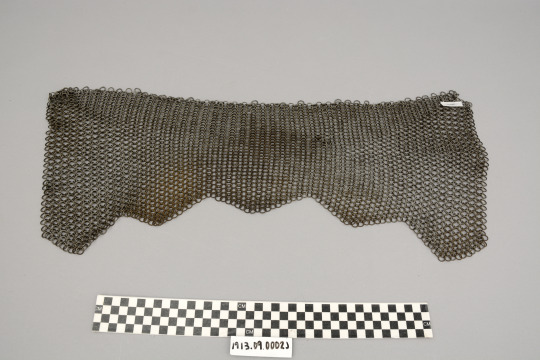
The alternative to a skirt was a brayette, which in the Renaissance became an actual plate-armour codpiece to echo civilian fashion (examples below) but in the Medieval era was a chainmail half-Speedo attached to the front of the hose, or a full-coverage section shaped like a nappy (diaper) which laced together into armoured britches.
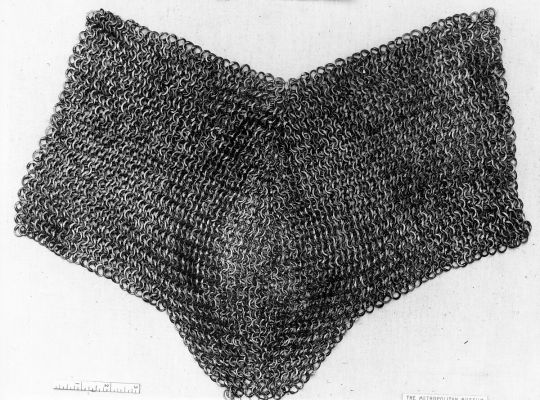
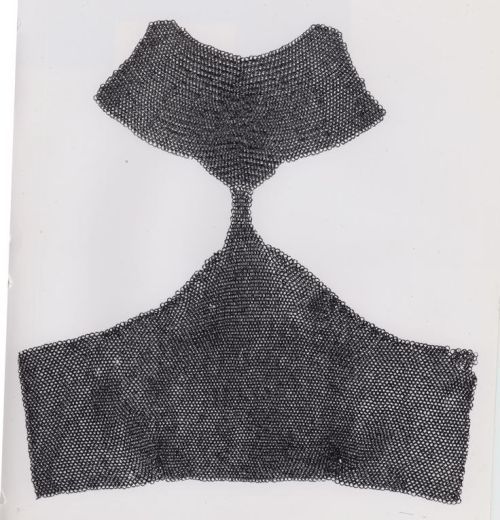
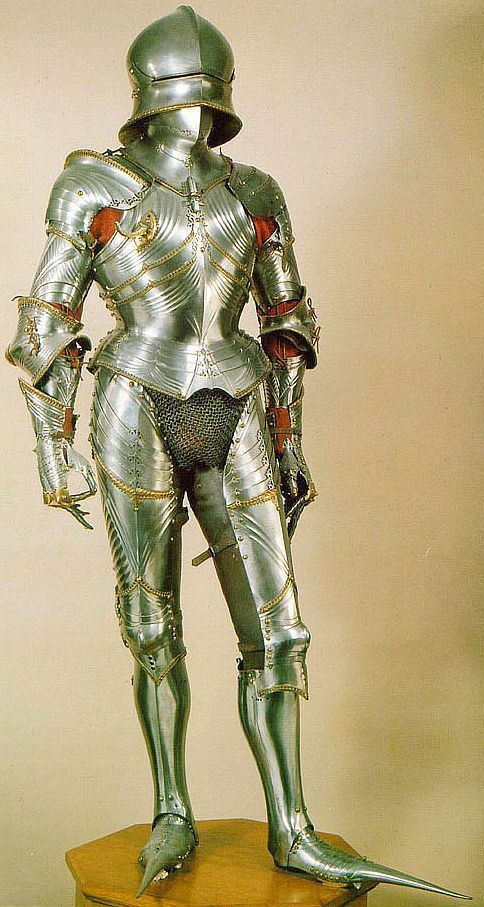
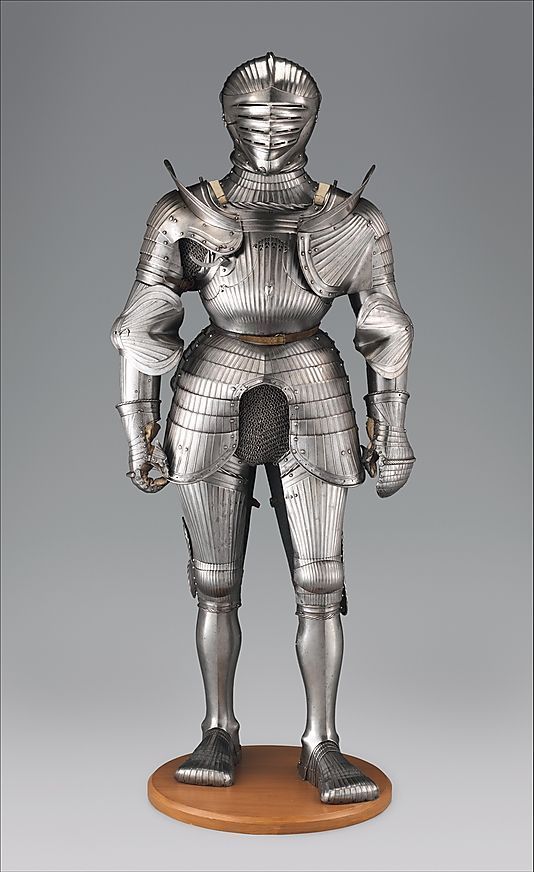
Armour for the rear (a "culet") was usually a short half-skirt of layered metal hoops connected to the matching half-skirt at the front (a "fauld")...
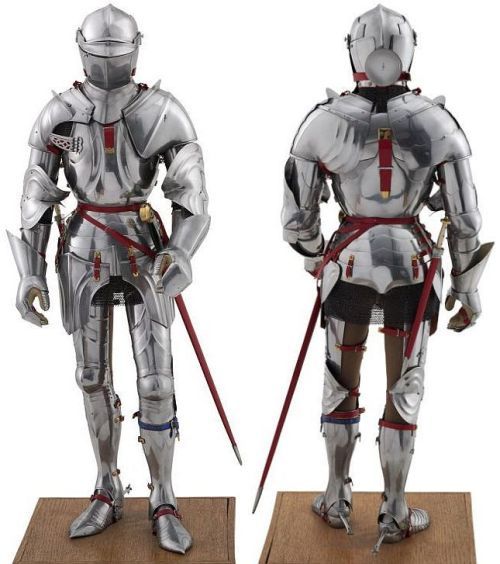
...but fully plated backsides were definitely made. They were rare, which makes me think they weren't much of an improvement or they'd be a lot more common.
The first two examples, made to imitate fashionable puff-and-slash clothing, are parade / costume armour purely for display and conspicuous consumption.
According to the Metropolitan Museum, NY, this was made in Augsburg by Kolman Helmschmied ("helmet-smith" - great name for an armourer!) possibly for Grand Hetman Jerzy Radziwiłł, a Polish nobleman.

The other parts of the armour are in the Musée de l'Armée, Paris.
Helmschmied also made this similar armour for Hofmeister Wilhelm von Roggendorf, an Austrian nobleman (it's in the Kunsthistorisches Museum, Vienna). Again, with those sleeves in place it's not made for fighting, just for parade, ceremony and generally Looking Impressive.
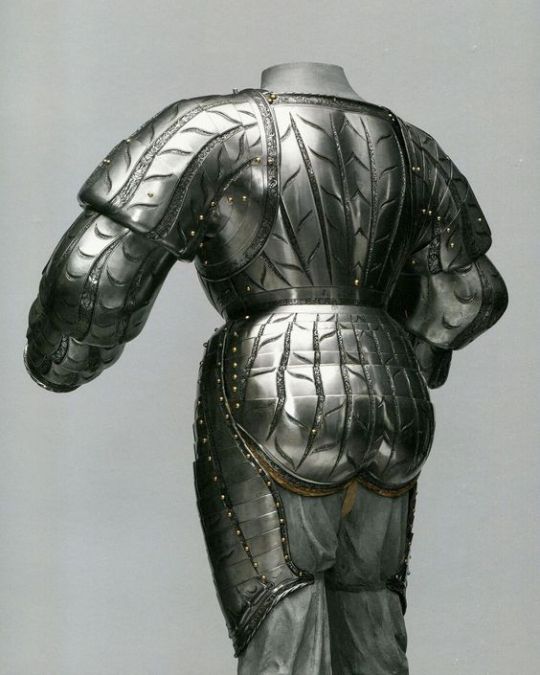
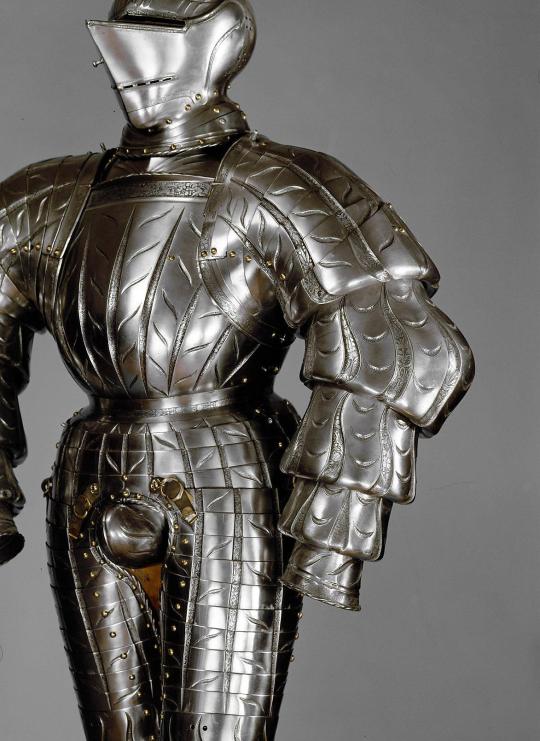
However, both these costume armours actually work. The "puffs" of the arms interlink freely, and the shoulders each have multiple interleaved plates (zoom in to see better) which slide over each other as the limb is raised or lowered. Same for its culet, the same short, flexible skirt as earlier armour plus an extra bit over the lower cheeks.
These armours were made as "garnitures" - interchangeable accessories for a real-life action figure, as here for George Clifford, Earl of Cumberland...
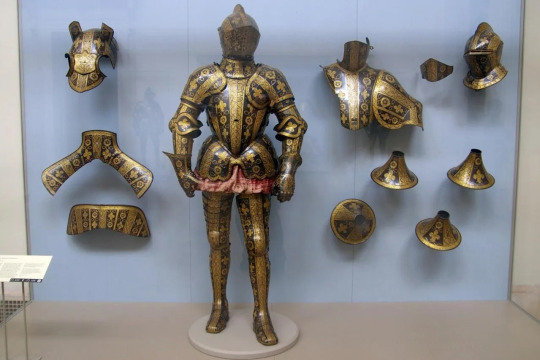
...and both of those fancy ones also have standard non-puffed arm plates and full leg protection for wear in tournament combat or actual war. It's likely the cheek-plate of the culet was also removed to make riding a horse more comfortable.
This last example was made from the outset for fighting; tournament fighting, but fighting nonetheless. It's Henry VIII's harness for foot combat at the Field of Cloth of Gold in 1520, when he was young and buff. This armour is so all-enclosing, with plates not mail at all the joints, that NASA examined it while developing the first space suits.

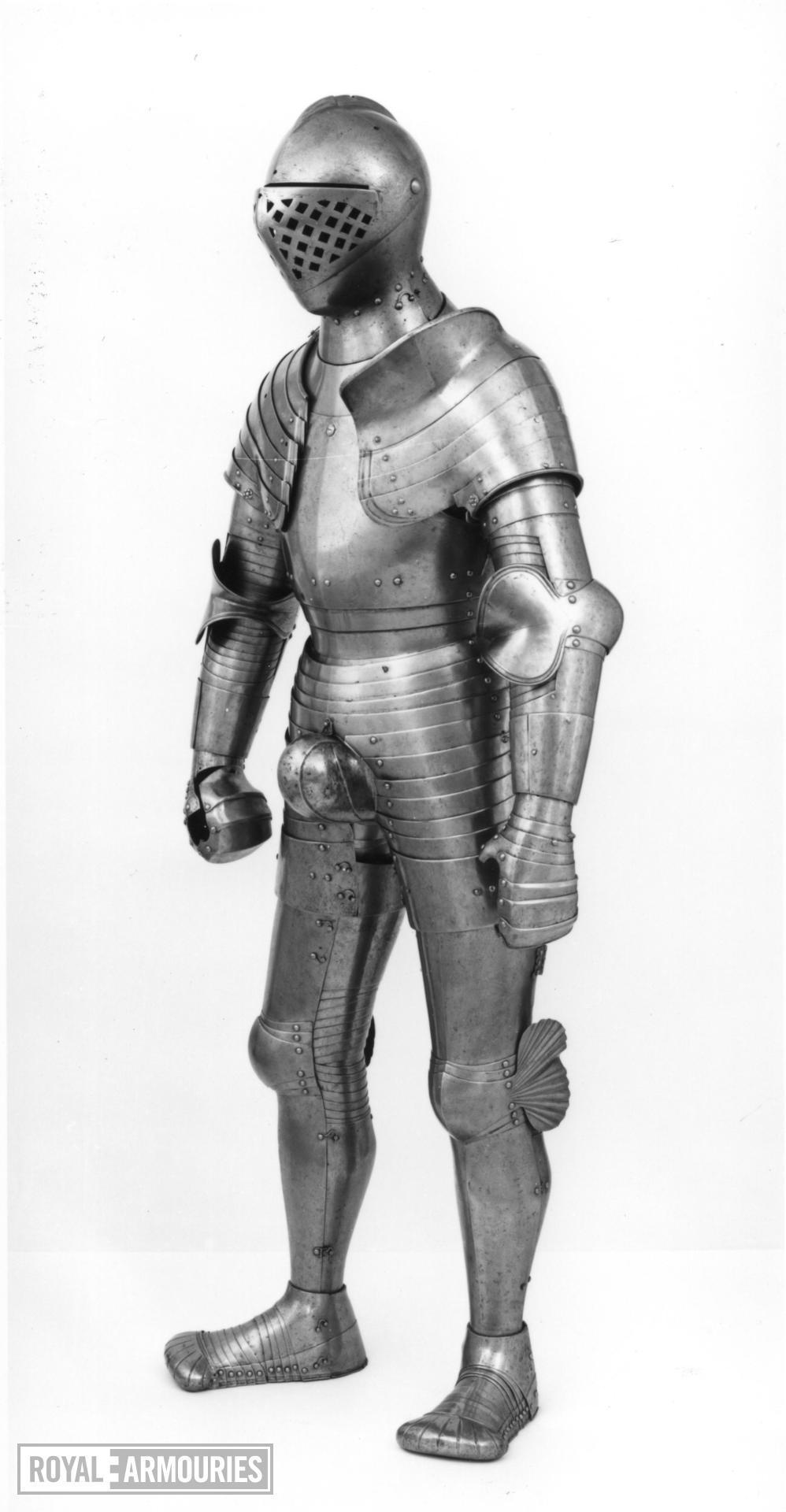
Age and injury stopped Henry from being active and trim, but being the King with no-one to say No, he kept on eating in the lavish the way he used to do when he was burning the calories, and it shows.
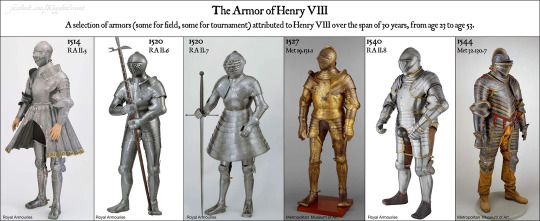
Here's a closer look at that last full armour made for him in 1540, again with buttock protection, though in this instance it was for mounted jousting so there was no need to armour the inner thighs and once again, on horseback he'd probably leave off the lowest plate.
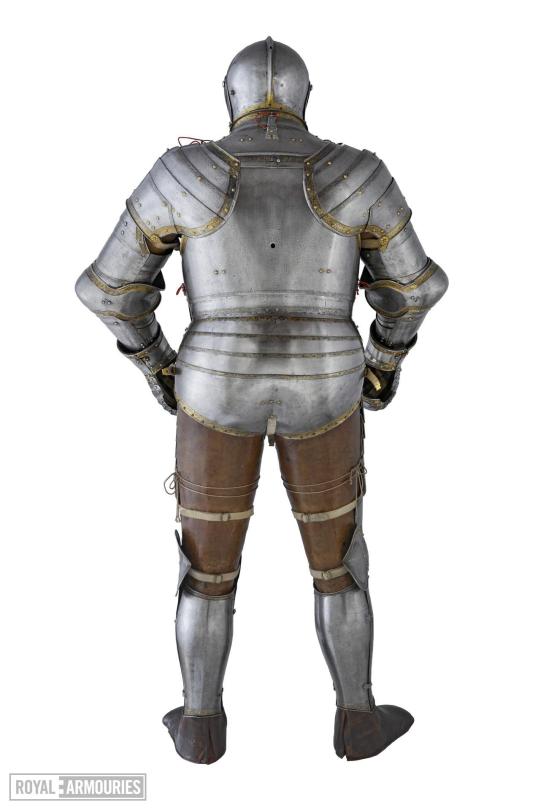
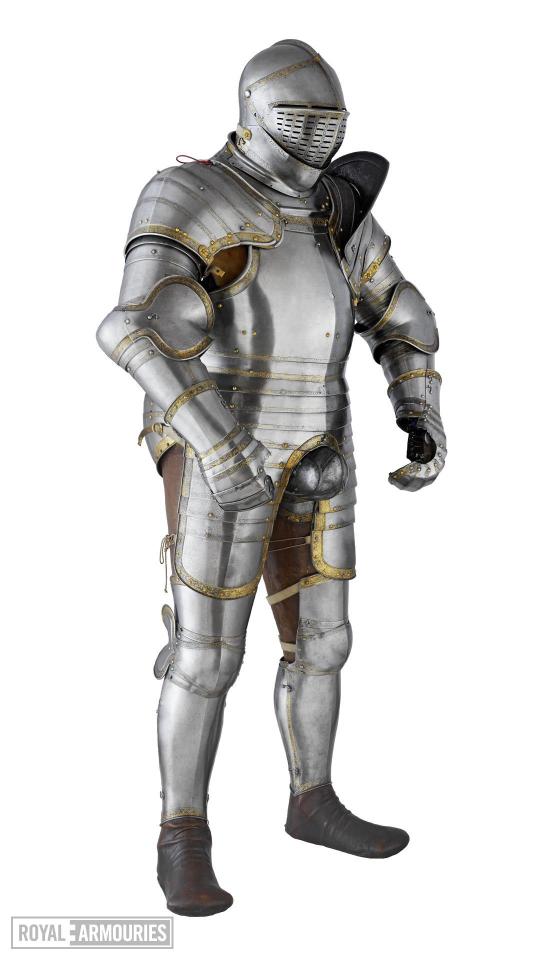
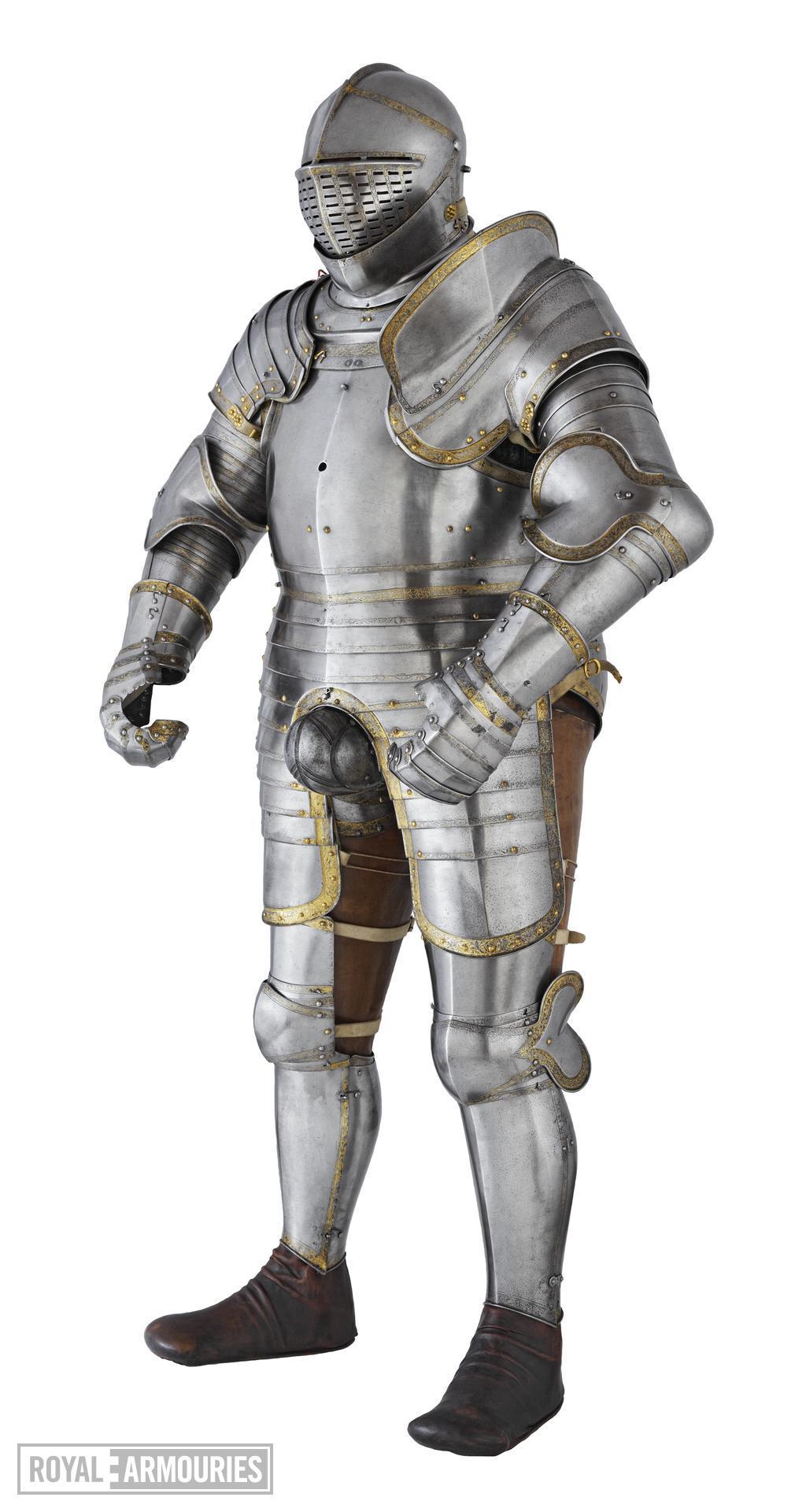
The large guard-plate on the left shoulder has a purpose, unlike the fan-shaped nonsense in the OP image.
It's there to shield against a weapon - here a lance - skidding off the shield and against the helmet. Jousting was almost always done left-side to left-side and armour was made with this in mind, though there was a German head-on-collision style (which required blindfolded horses because the horses were otherwise far too sensible to run straight at each other).
Yes indeed, that high plate prevented the left arm from being fully raised (Henry's foot-combat armour has a much smaller, less obstructive one) but the left arm of a jousting armour didn't NEED to be fully raised.
In some styles of jousting not just the left but both arms had a limited range of motion...
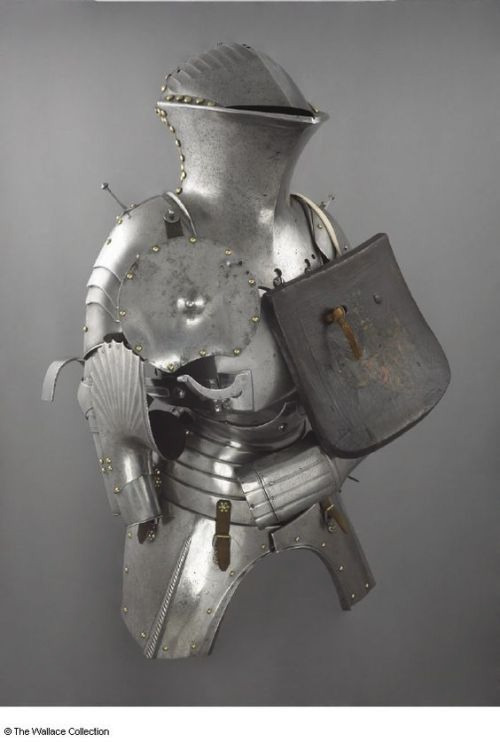
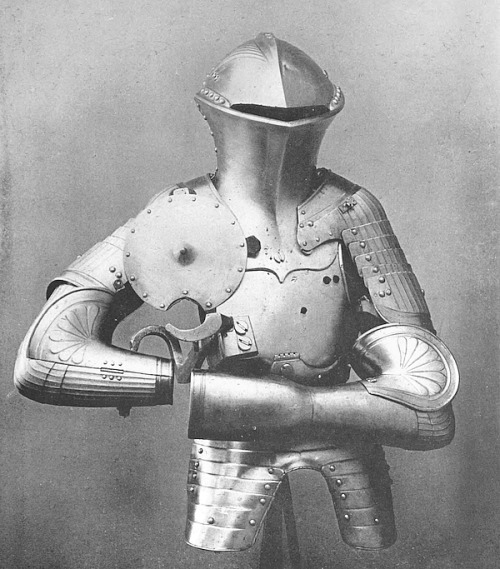
...since holding the lance, supporting the shield (in this example not even that, it's attached to the breastplate by a rope through two holes) and gripping the reins was all they had to do.
During a 30-40 mph collision when the weight and momentum of two armoured men and two often-armoured horses was concentrated into the points of their lances, being well protected against those points was much more important than being able to scratch your nose, as if you could even get at it inside your helm.
Even with those limitations, properly made armour meant being able to walk, ride and fight while wearing it - while at the same time not slicing its wearer's ears off or impaling them on bits of their own equipment
Little details, and not visually impressive, but throughout the whole of armour-wearing history they were regarded as more important features than yet another array of spikes.
Which BTW is not what's meant by "sharply dressed", and never was...
;->
Yeah, no
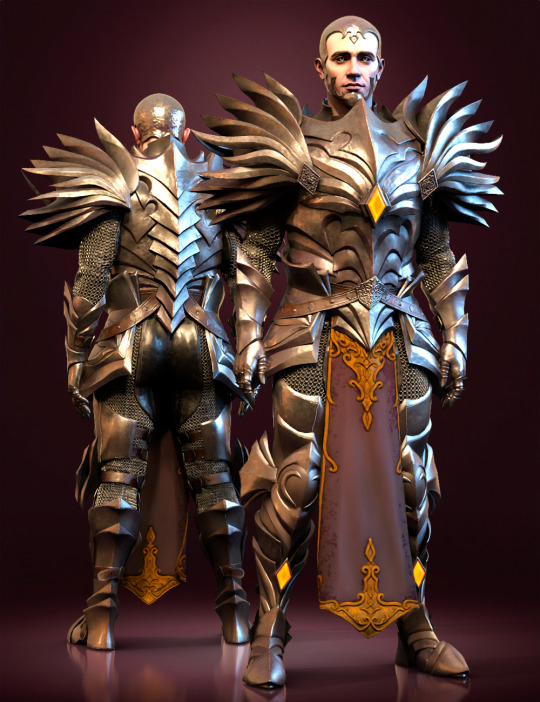
If I’m going to buy digital armor, it’ll be a set I can actually rationalize a human fighter wearing. This… would not be it.
#arms and armour#stupid fantasy armour#plate armour#armoured backside#Wilhelm von Roggendorf#Henry VIII#costume armour#parade armour#jousting armour#range of motion
298 notes
·
View notes
Text

The one, the only, Jaime Lannister
Confession time... I'm a big redemption-arc Jaime apologist. Season 8 was a betrayal on every level and I reject D&D's decisions with Jaime. In a hilarious/devestating twist season 8 episode 2 was the second episode I'd ever watched (the first was the Sand-Snake vs Greyjoy episode with my cousins, and s8ep2 I watched when it came out with my friend) and it hooked me enough to give the rest of season 8 a fighting chance (guess how that went). So... I was already a Braime stan via the books and 8x02... there's a reason I'm still raging all these years later. I was already set up for failure with my Beauty and the Beast retellings obsession... I have to stop or I'll never stop. Anyway, Jaime apologist, I've decided he and Brienne have a happy ending. Who is your problematic asoiaf fave?
I am the artist! Do not post without permission & credit! Thank you! Come visit me through my link tree on: instagram, tiktok or check out my coloring book available now \ („• ֊ •„) /
#jaime lannister#house lannister#digital illustration#historically inspired#redesigning game of thrones#valyrian scrolls#ellenart#lnart#character design#costume design#hear me roar#fictional fashion#knights in armour#armor is a pain to draw so give me grace
448 notes
·
View notes
Text
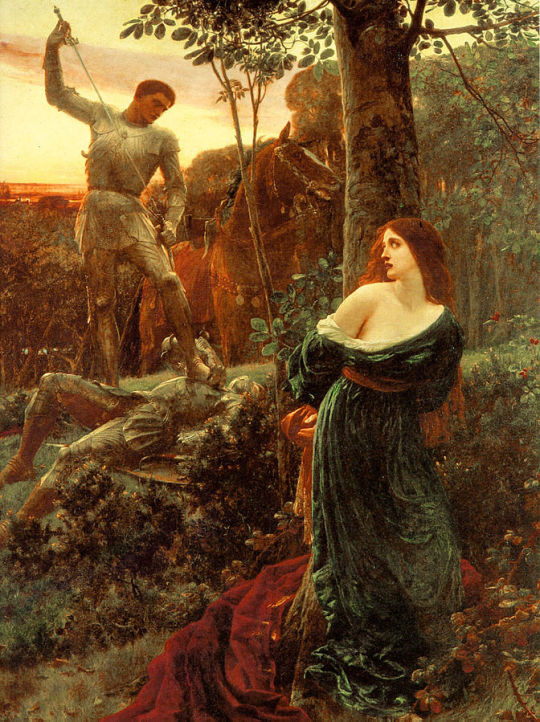
Frank Dicksee (1853-1928) "Chivalry" (1885) Oil on canvas
#paintings#art#artwork#allegorical painting#chivalry#frank dicksee#oil on canvas#fine art#english artist#british artist#history painting#knight#knighthood#costume#costumes#armor#armour#female portrait#portrait of a woman#male portrait#portrait of a man#violence#death#1880s#late 1800s#late 19th century
388 notes
·
View notes
Text


Masterpost
#dungeon meshi#delicious in dungeon#dunmeshi spoilers#spookiest monster costume on the marcille tournament#living armour#fairy#marcille donato
127 notes
·
View notes
Text


armour design by eiko ishioka
#eiko ishioka#gary oldman#count dracula#bram stocker's dracula#dracula's armour#costume design#horror#vampires
91 notes
·
View notes
Text
things to be insane about today: the knight of wands/energetic warrior card reading. phil literally predicted dan coming into his life. i can’t imagine a more vaguely accurate description of him. how the fuck are they real. phil did go and change the world in ways he could have never imagined.
#this is a draft from this morning but feels appropriate with the dumb knight costume#dan is literally his knight in shining armour like let’s be serious#dnp#dan and phil#phan#daniel howell#phil lester
139 notes
·
View notes
Text

I don't have many photos of the shield since I added the decals to it, but here you go:
TRANS KNIGHTS ARE HUMAN KNIGHTS
#knight#knightess#queer#pride#trans#transgender#armor#armour#shield#sword#butch#dyke#gay#wlw#t4t#larp#cosplay#costume
880 notes
·
View notes
Text

Armoured Hose (possibly German), early 16th century This pair of Hose is made of linen, which was used as both top fabric and lining. Between both layers, approx. 950 small metal plates were sewn in with linen thread. Around the knee, chainmail was used instead of metal plates - most likely for better movability. The long slits on the inside of the legs could be laced tight for a better fit. As the legs of the Hose are not connected (except for one small area just below the waistband), they were most likely worn on top of another pair of Hose, or at least a pair of short underpants.
Textile armour was quite popular during the 16th century - many people used armoured trousers and doublets as (cheaper?) alternative to conventional plate armour.
This garment is exhibited at the Bayerisches Armeemuseum in Bavaria, Germany.
#historical fashion#16th century#historical costuming#renaissance#renaissance fashion#16th century fashion#fashion history#history#armour#plate armor#armor
75 notes
·
View notes
Text

Aaaaaaaand finally managed to publish thiiiissssssssss!!!!! :D


Really silly, I know
@gethoce
#kirby oc#kirby#fal mahoiku#fal#my draws#silly doodles#valfrey#other ocs#the last two drawings were... difficult#I wanted to do another one with Valfrey reacting to Snow's Halloween costume but#*looks at Valfrey armour* sorry but I am at my limit and too many lines...#i hope u like this Gethoceeeeeeeee!#fun fact: Back then in the tournament i only had three red colours. One of them was actually magenta#i got MORE COLOURS and MORE REEEEEEED so drawing OCs like Valfrey or Anti who have lots of red isn't difficult anymoreeeeeeee :'3
30 notes
·
View notes